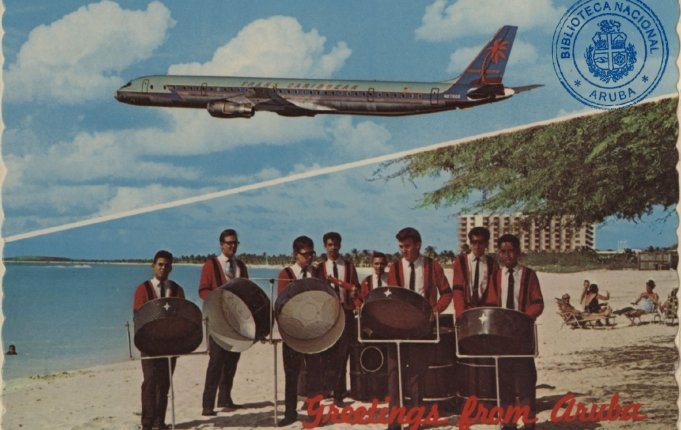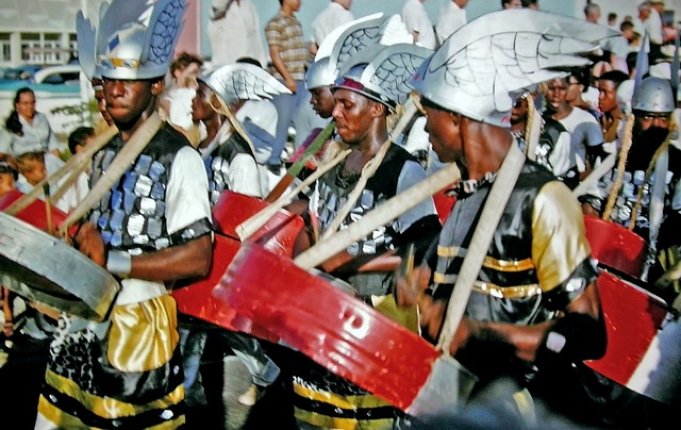Balashi Brewery is honored to be named by SMAC (Aruba’s organizing body for all things Carnival) as the official beer for Carnival 70. Balashi is Aruba’s beloved national beer, proudly brewed locally at Balashi Brewery. The partnership reflects Balashi’s connection with Aruba’s authentic culture, and the island’s Carnival season is the cherished highlight of a nation rich in heritage and traditions. In this blog, Balashi is proud to put the spotlight on the music behind the island’s biggest party season!
Music is both the language and the fuel of Aruba’s Carnival, providing the soundtrack for events throughout the festive season. During parades, various Carnival groups have their own traveling band (usually positioned atop a tractor trailer’s flatbed), dictating the pace and energy of the revelers’ shuffling, jumping, and jiving to the beat. The beats are contagious, and the excitement of the group members flows into the parade watchers gathered alongside the barricades on both sides of the road. Each Carnival makes way for new songs of the season, which are typically debuted at various Carnival music competitions.

Calypso and road march are the rhythm, and many say, the soul of Aruba’s Carnival. Both styles of music were brought to Aruba with the British Caribbean immigrants working at the refinery in San Nicolas. It wasn’t long before Aruba created its own special brand of calypso and road march songs, with a cast of talented characters making musical history on the island throughout the years.
Calypso music typically blends humor with social and political commentary, woven throughout the stories about the year’s events and happenings. A calypso song is usually meant as a challenge—to society at large, to the evening’s audience, and most commonly, to another calypsonian. On the other hand, the road march is tasked with delivering the theme song of Carnival. It’s very beat-driven, as the tune must carry the pace of the parades throughout the season. It starts with an introduction, usually elaborate, which makes use of brass instruments to create the recognizable lick of the song. The introductory part is repeated a few times until the “breakaway” moment when the brass instruments take over the leading tune. The break in the song is intended to give a dancing kick to the people and get them to join in singing.
Local musicians like Claudius “Mighty Talent” Phillips and the late Hildward Croes have played a major role in creating a style of road march that is completely Aruban. While Hildward was known for incorporating the elements of jazz and funk into road march, Claudius is known for bridging the music of the previous generations, including steel pan, with modern music forms. Perhaps Claudius’ musical wizardry was at its best in 1995 when he weaved magic into an old song from the island of Dominica to create “Sac’e Boem Boem,” which eventually went platinum.
Each Carnival season, a calypso and road march competition, now called the Caiso & Soca Monarch, is held at the Carnival Village in San Nicolas, with preliminaries often lasting several nights. (Caiso is the modern name and style of calypso, and soca is the international name for road march.) On the final night, thousands gather under the stars to hear the best of the best and cheer for their favorite singers and bands. Although the official winners—a Caiso Monarch and a Soca Monarch—are crowned by a jury, it is the crowd that determines which performers and songs they want to hear on the parade routes. The public’s favorite songs make their way into the rest of the season’s parades, and although some years there are several crowd favorites, there is always one that brings the most electric energy to the parades and events and gets the most airtime on local radio stations. This song becomes known as the season’s Road Jam.
.jpg)
Tumba is a musical genre with an African background that first took root on the neighboring island of Curaçao, eventually spreading to Aruba and Bonaire. Evolved from the tambu rhythm and distinct drumbeat brought to Curaçao in the 17th century by African slaves, tumba in the Dutch Antilles incorporates several musical instruments to accompany the drumbeats, becoming a hybrid of sorts, with merengue influence as well. Aruba’s tumba sound is noted as being more melodic, while Curaçao keeps the emphasis on rhythm, tempo, and arrangements.
Aruba’s tumba competition is held during the Carnival season, with songs traditionally sung in the native language of Papiamento and often filled with lyrics vocalizing community and Carnival commentary.
In the earliest years of Aruba’s Carnival, revelers paraded in the streets of San Nicolas to steel pan music, a musical import from Trinidad. Melodic music emanated from oil drums (sourced from the Lago refinery) that were cut and beaten to form various scales to produce a rich sound. Some of the island’s first steel drums were made by Trinidadian refinery worker Leonard “Shoo Shoo Baby” Turner, who by 1948, had put together Aruba’s first steel band, the Invaders. (Many other steel legends followed, including Dennis Jones, Paul Connor, and Edgar Connor.) At the peak of their popularity, steel bands could number over 40 musicians. The musicians were quite the sight, walking in a parade often trapped in huge cage-like contraptions specially designed to hold the heavy pans, all the while producing the merry sounds to which the crowds danced endlessly.
Steel bands are still an important thread within the island’s overall cultural fabric, but their role in Carnival today is more symbolic. If today an occasional steel band joins a Carnival parade, its performance is meant more as a tribute to an epoch that inspired the first local talents, whose influence still echoes in today’s Carnival music creations on the island.

The first brass bands emerged here in the 1960s, signaling the end of a great musical era in Aruban Carnival—that of steel bands. The first brass brand to participate in Aruba’s Carnival was formed by Arnold Beyde and Samuel Hodge. Beyde and Hodge invented the steady beat—influenced by the rhythms of samba, calypso, and march—that is today recognized as the brass band rhythm of Aruba.
Much like the high school and college marching bands in the US, where the performance of the band members is just as fun as the rhythm of the music, Aruba’s brass bands add another dimension to the Carnival music scene. These marching acoustic entourages typically lead the parades, with funky, hip-swaying rhythms pumped out by the drum line, joined by the bold trumpeting of the brass section. Locals know when they hear the brass band in the distance that the parade is just around the corner!
